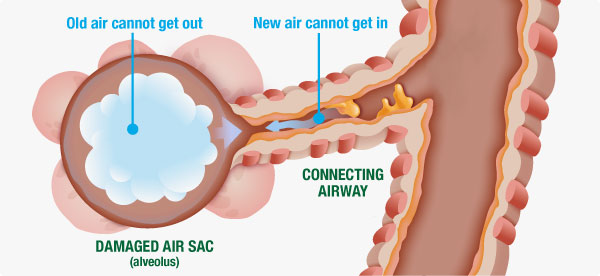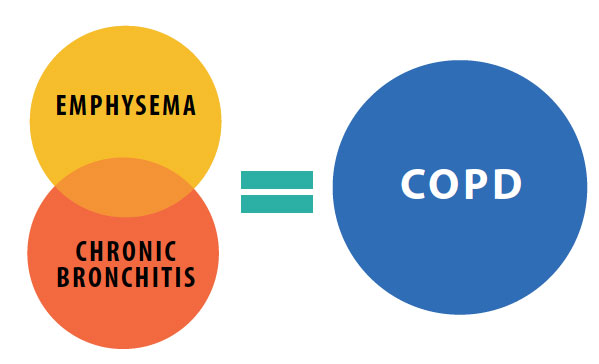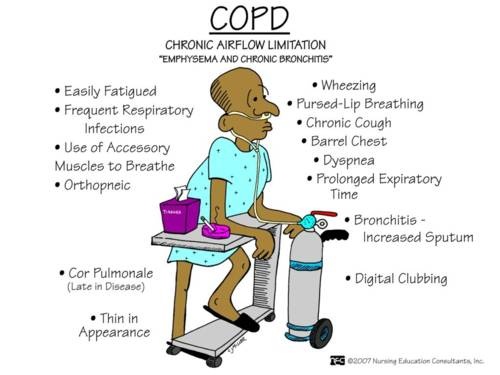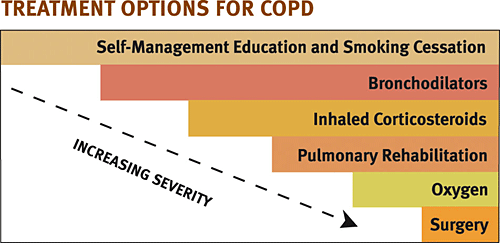You already know a lot about COPD without realizing it or even having to think about it. You’ve seen patients walking around with the oxygen tanks or tubes in their noses. However, that’s just the extreme. COPD is the third or fourth leading cause of death in the US depending on the source, with millions of individuals diagnosed. You also know COPD and cancers are why your doctors always warn you against smoking in any form. You know smoking is the leading cause of this. This Straight, No Chaser provides a brief overview of COPD and answers some key questions.
What Is COPD?
Chronic obstructive pulmonary disease is a lung disease that makes it hard to breathe and advances in severity over time.
Appreciate that air goes from your mouth or nose through the windpipe (trachea) through several branches of airways, eventually connecting to blood vessels meant to carry oxygen to the organs of your body. These same blood vessels drop off waste gas known as carbon dioxide, which we exhale with each breath out. In COPD, less air flows in and out of the airways because of one or more of the following:
- The airways and air sacs lose their elasticity. Elasticity is the stretchiness your lungs need to fill up with and push out air. In COPD, these sacs act less like a balloon and more like a lead pipe.
- The airways make more mucus than usual, which clog them and make breathing more difficult. The inflammation caused by smoke and other irritants produce mucus. It’s not a good thing when instead of breathing air, you’re attempting to breathe a smoke-filled swamp of snot-like material.
- The walls of the airways become thick and inflamed. Over time, inflammation can cause permanent changes in the walls of the airways to compensate for the environment you’ve created.
- The walls between many of the air sacs are destroyed. Ongoing inflammation overwhelms the body’s ability to repair itself, and eventually sheets of tissue in your airways are destroyed beyond repair, providing you with less tissue to exchange oxygen from the lungs to the blood vessels that carry oxygen through the body.
What causes COPD?
Cigarette smoking is far and away the leading cause of COPD. Most of those with COPD are current or former smokers. Heredity, childhood respiratory infections, and long-term exposure to other lung irritants, such as air pollution, chemical fumes, or dust may contribute to or cause COPD.
I’ve been told I have bronchitis. Is that the same thing?
There’s acute bronchitis, and there’s chronic bronchitis. In the US, COPD refers to two separate but similar conditions, emphysema and chronic bronchitis; most with COPD have both conditions. Now if you have acute bronchitis, it means something (like and likely cigarette smoke) is currently inflaming your airways. Over time this can permanently damage the airways and produce an ongoing state of inflammation – chronic bronchitis – with airway wall thickening and increased mucus production within the lungs. Let the smoker beware.
How is this different from emphysema?
In emphysema, the walls between many of the air sacs are damaged, losing their shape and elasticity. This damage also can destroy the walls of the air sacs, leading to fewer, larger and less efficient air sacs instead of many more efficient tiny ones. If this happens, the amount of gas exchange in the lungs is reduced, meaning you’re not getting enough oxygen in you and enough carbon dioxide out of you.
What are some symptoms of COPD?
COPD can cause coughing with mucus production, wheezing, shortness of breath, chest tightness, decreased ability to exert yourself and walk around. Even more symptoms may develop as a result of inadequate oxygen supply and inadequate carbon dioxide disposal.
How can I know if I have COPD?
One big problem with COPD is many have the disease and don’t know it until it starts becoming quite advanced. It’s safe to assume that if you’re a smoker and have difficulty breathing, you’re experiencing changes to your airways that aren’t in your best interest. You are advised to get evaluated. You are best advised to remove yourself from the source of the inflammation (in other words, stop smoking).
How does COPD affect my life?
For starters, it shortens it. It also markedly increases your cancer risk. At some point all the damage and changes to your lungs is going to cause some abnormality. Given this is the area you use to breath, deliver oxygen to your organs and eliminate toxins from your body, all manners of things can go wrong, and they often do. COPD is a chronic, progressive disease. You may or may not pick up on the slow creep of diminishing ability to perform routine activities, or maybe you’ll just attribute them to aging (COPD occurs most often in middle-aged to elderly individuals). Once severe enough, COPD may prevent you from doing even basic activities like walking, breathing without difficulty, or taking care of yourself.
What’s the cure for this?
Here’s the frightening part: we’re talking about irreversible lung tissue change and destruction. Once layers of your airways have been ripped out (figuratively), they aren’t coming back. The damage is done. Prevention is your best defense.
So how is it treated?
There is no real treatment without removing the trigger feeding the ongoing inflammation. In other words, you’ll have to stop smoking to attempt to arrest the progression. Additional measures involve support.
- Supplemental oxygen may be needed to deliver enough oxygen to the tissues as an effort to combat the destruction and inflammation of tissue meant to facilitate oxygen exchange.
- Medicines to reduce the inflammation and mucus may be prescribed.
- Medicines to better open the airways past the clogging caused by inflammation and mucus may be prescribed.
Your physician will discuss these and other options. The truth is COPD has no cure. Once you’re discovered to have COPD, efforts switch to slowing the progression and implementing measures to improve the quality of your life within the parameters defined by the advancement of your disease.
Here is a short video from the National Institutes of Health.
https://www.youtube.com/watch?v=BIdHQQEXPDk#action=share
Thanks for liking and following Straight, No Chaser! This public service provides a sample of what 844-SMA-TALK and http://www.SterlingMedicalAdvice.com (SMA) offers. Please share our page with your friends on WordPress. We are also on Facebook at SterlingMedicalAdvice.com and Twitter at @asksterlingmd.







